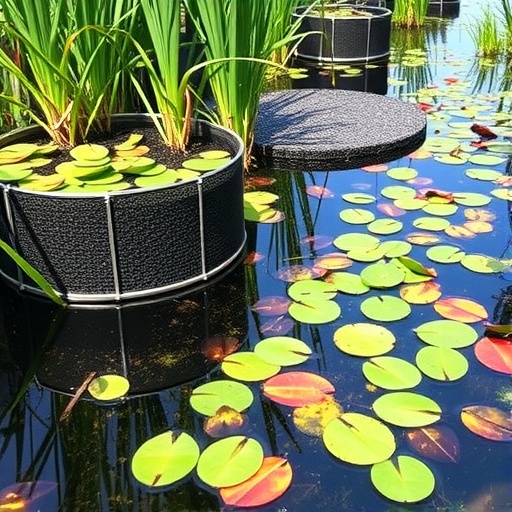In recent years, the quest for effective and sustainable wastewater treatment solutions has garnered significant attention. A pivotal study conducted by El Barkaoui et al. delves into this pressing environmental challenge, examining the influence of organic loading rates on the efficacy of olive pomace biochar-enhanced vertical flow constructed wetlands. This innovative research emerges at a time when traditional wastewater treatment methods are scrutinized for their environmental impacts, making it imperative to explore eco-friendly alternatives.
In the context of global water scarcity and pollution, constructed wetlands have emerged as a viable solution for wastewater treatment. These systems mimic natural wetland processes, leveraging plant and microbial interactions to purify water. However, the effectiveness of constructed wetlands can be highly variable, influenced by factors such as organic loading rates, which directly affect the biodegradation processes within these systems. The study led by El Barkaoui and his colleagues examines how adjusting these organic loading rates can optimize wastewater treatment, a critical step toward enhancing the overall sustainability of these systems.
The incorporation of biochar, specifically olive pomace biochar, is a central theme in this research. Biochar, a carbon-rich material derived from biomass through pyrolysis, has gained recognition for its water retention properties, nutrient adsorption capacity, and ability to enhance microbial activity. Olive pomace, a byproduct of olive oil production, presents an abundant source of biochar. The study explores how integrating this byproduct into vertical flow constructed wetlands can improve their treatment performance, addressing both waste utilization and environmental restoration.
One of the key findings of the study is the relationship between organic loading rates and the treatment efficiency of constructed wetlands enhanced with olive pomace biochar. The researchers conducted a series of experiments, varying the organic loading rates to identify optimal conditions for wastewater treatment. Their results indicate that higher organic loading rates, when complemented by biochar, yield significantly improved removal efficiencies for contaminants such as nutrients and organic matter.
The study meticulously outlines the methodologies employed in the experiments, providing a transparent view into how the research was conducted. This included the design of the vertical flow constructed wetlands, the processes of biochar preparation, and the parameters monitored during the treatment. By detailing these aspects, the research not only showcases its findings but also underscores the reproducibility of such experiments, encouraging further investigations in this field.
Furthermore, the implications of the findings extend beyond theoretical discourse. Implementing biochar-enhanced constructed wetlands with a keen understanding of organic loading rates could revolutionize the way we approach wastewater treatment. The ability to utilize local byproducts such as olive pomace not only addresses waste management issues but also contributes to a circular economy by promoting resource recovery. This paradigm shift towards sustainability aligns with global efforts to mitigate environmental degradation and combat water scarcity.
As the world grapples with the effects of climate change and industrial pollution, innovative solutions like the ones proposed in this research are essential. The concept of integrating agricultural byproducts into wastewater treatment systems highlights a holistic approach to environmental management. Such strategies are particularly relevant in regions with strong agricultural sectors, where waste products can be effectively repurposed while providing cleaner water solutions.
The study also sheds light on the operational aspects of constructed wetlands, emphasizing the need for continuous monitoring and optimization. As organic loading rates fluctuate in real-world applications, the adaptability of biochar-enhanced systems could prove vital in maintaining treatment efficiency. The research proposes a framework for future studies to explore the long-term performance and resilience of these systems under varying climatic and operational conditions.
In summary, the research conducted by El Barkaoui et al. presents a significant step forward in the quest for effective and sustainable wastewater treatment solutions. By focusing on the synergistic effects of organic loading rates and olive pomace biochar in vertical flow constructed wetlands, the study provides valuable insights that can influence both academic research and practical applications. This work not only advances our understanding of constructed wetlands but also offers an innovative pathway to enhance their performance, driving us closer to sustainable water management practices.
Ultimately, this research is a call to action for further exploration into biochar applications and the optimization of constructed wetlands for wastewater treatment. As we face increasing environmental challenges, embracing such innovative solutions could pave the way for a cleaner, more sustainable future, where waste is not merely discarded but utilized to foster ecological resilience and restore natural water systems.
Subject of Research: The effect of organic loading rates on olive pomace biochar-enhanced vertical flow constructed wetlands for wastewater treatment.
Article Title: Effect of organic loading rates on olive pomace biochar-enhanced vertical flow constructed wetlands for wastewater treatment.
Article References:
El Barkaoui, S., Ouazzani, N., Ryah, H. et al. Effect of organic loading rates on olive pomace biochar-enhanced vertical flow constructed wetlands for wastewater treatment.
Environ Sci Pollut Res (2025). https://doi.org/10.1007/s11356-025-37083-y
Image Credits: AI Generated
DOI: 10.1007/s11356-025-37083-y
Keywords: wastewater treatment, constructed wetlands, organic loading rates, biochar, olive pomace, sustainability, environmental management, water quality.




